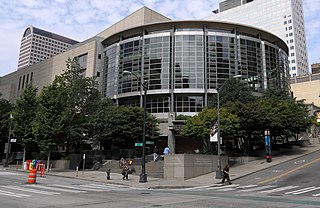
Minoru Yamasaki was an American architect, best known for designing the original World Trade Center in New York City and several other large-scale projects. Yamasaki was one of the most prominent architects of the 20th century. He and fellow architect Edward Durell Stone are generally considered to be the two master practitioners of "New Formalism".
Leslie Earl Robertson was an American engineer. He was the lead structural engineer of the Twin Towers of the original World Trade Center in New York City, and served as structural engineer on numerous other projects, including the U.S. Steel Tower in Pittsburgh, Shanghai World Financial Center, and the Bank of China Tower in Hong Kong.

The Seattle Central Library is the flagship library of the Seattle Public Library system. The 11-story glass and steel building in downtown Seattle, Washington was opened to the public on May 23, 2004. Rem Koolhaas and Joshua Prince-Ramus of OMA/LMN were the principal architects, and Magnusson Klemencic Associates was the structural engineer with Arup. Arup also provided mechanical, electrical, and plumbing engineering, as well as fire/life safety, security, IT and communications, and audio visual consulting. Hoffman Construction Company of Portland, Oregon, was the general contractor.

Benaroya Hall is the home of the Seattle Symphony in Downtown Seattle, Washington, United States. It features two auditoria, the S. Mark Taper Foundation Auditorium, a 2500-seat performance venue, as well as the Illsley Ball Nordstrom Recital Hall, which seats 536. Opened in September 1998 at a cost of $120 million, Benaroya quickly became noted for its technology-infused acoustics designed by Cyril Harris, touches of luxury and prominent location in a complex thoroughly integrated into the downtown area. Benaroya occupies an entire city block in the center of the city and has helped double the Seattle Symphony's budget and number of performances. The lobby of the hall features a large contribution of glass art, such as one given the title Crystal Cascade, by world-renowned artist Dale Chihuly.

HNTB Corporation is an American infrastructure design firm that was founded in 1914. The firm has numerous offices across the United States, and has designed many sports facilities, airports, bridges, tunnels, roadways, and rail and transit systems across the United States and around the world.

HDR, Inc. is an employee-owned design firm, specializing in engineering, architecture, environmental, and construction services. HDR has worked on projects in all 50 U.S. states and in 60 countries, including notable projects such as the Hoover Dam Bypass, Fort Belvoir Community Hospital, and Roslin Institute building. The firm employs over 11,000 professionals and represents hundreds of disciplines in various markets. HDR is the 10th largest employee-owned company in the United States with revenues of $2.5 billion in 2021. Engineering News-Record ranked HDR as the 5th largest design firm in the United States in 2022.
The Residences at Greenbelt – San Lorenzo Tower is a residential condominium skyscraper in Makati, Philippines. It is the second of three buildings being constructed as part of The Residences at Greenbelt (TRAG) complex, and is the highest of the three. It is the 11th-tallest building in the country and Metro Manila as well with a height of 204.5 metres from the ground to its architectural spire.
The Residences at Greenbelt – Manila Tower is a residential condominium skyscraper in Makati, Philippines. It is the third of three buildings constructed as part of The Residences at Greenbelt (TRAG) complex, and has a similar dimension to The Residences at Greenbelt - Laguna Tower. It is one of the tallest skyscrapers in the Philippines with a height of 170.75 meters (560.2 ft) from the ground to its architectural top.
The Residences at Greenbelt – Laguna Tower is a residential condominium skyscraper in Makati, Philippines. It is the first of three buildings being constructed as part of The Residences at Greenbelt (TRAG) complex, and is the basis of the now being constructed The Residences at Greenbelt - Manila Tower. It is expected to be one of the tallest skyscraper in the Philippines with a height of 170.75 metres from the ground to its architectural top.

William Frazier Baker, also known as Bill Baker, is an American structural engineer known for engineering the Burj Khalifa, the world's tallest building/man-made structure. He is currently a structural engineering partner in the Chicago office of Skidmore, Owings & Merrill, LLP (SOM).
The One Roxas Triangle, also known as the One Roxas Triangle Tower 1 or Roxas Triangle Tower One, is a residential condominium skyscraper located in Makati, Philippines. It is owned by Roxas Land Corp., and was developed by the combined efforts of Ayala Land, Inc., Hongkong Land, Ltd. and Bank of the Philippine Islands. It stands at 174.3 metres, it is currently the 8th-tallest complete building in Makati, and the 15th tallest complete building in the Philippines.
Simpson Gumpertz & Heger Inc. (SGH) is a privately held ENR 500 engineering firm that designs, investigates, and rehabilitates structures and building enclosures. Their work encompasses commercial, institutional and residential buildings, transportation, water/wastewater, nuclear, science, and defense structure projects throughout the U.S. and over twenty foreign countries. SGH has 625 employees at eight offices in Atlanta, Boston, Chicago, Houston, New York City, Oakland, Southern California and Washington, D.C.
John Skilling was a civil engineer and architect, best known for being the chief structural engineer of the World Trade Center.
REX is an architecture and design firm based in New York City, whose name signifies a re-appraisal (RE) of architecture (X). Seminal projects include the Dee and Charles Wyly Theatre in Dallas, Texas; the Vakko Fashion Center in Istanbul, Turkey; and the Seattle Central Library. The work of REX has been recognized with accolades including two American Institute of Architects' National Honor Awards in 2005 and 2011, a U.S. Institute for Theatre Technology National Honor Award, an American Library Association National Building Award, and two American Council of Engineering Companies' National Gold Awards.
RCBC Plaza is an office skyscraper complex located in Makati, Philippines. It is home to the offices of the Rizal Commercial Banking Corporation (RCBC) and is composed of two buildings: the taller RCBC Plaza Yuchengco Tower and the smaller RCBC Plaza Tower 2. The taller tower stands at 192 meters (630 ft) from the ground to its architectural top, and is currently the 8th-tallest complete building in Makati, and is the 16th-tallest building in the Philippines, while the shorter tower stands at 170 meters (560 ft). At the time of its completion, the complex, as a whole, was considered by its developers to be the largest and most modern office development in the country.

The United States Courthouse in Seattle, Washington, is a federal courthouse and office building used primarily by the United States District Court for the Western District of Washington. When it opened on August 17, 2004, at a cost of $171 million, it replaced the historic William Kenzo Nakamura United States Courthouse, which has since been transferred to the United States Court of Appeals for the Ninth Circuit. The 23-story, 390-foot (120 m) tall building houses 18 courtrooms and 22 chambers and occupies a full city block along with a landscaped public plaza.

150 North Riverside Plaza is a highrise building in Chicago, Illinois, completed in 2017 and anchored by William Blair and Co. The building is 54 stories tall. The building occupies a two-acre site on the west bank of the Chicago River, whose size and location demanded an unusually small base for the building. The building features 1.2 million square feet (110,000 m2) of leasable office space. Due to its unique superstructure design, it encompasses just 25 percent of the lot. In 2019, the building was given the Chicago Chapter of the American Institute of Architects' highest award for design excellence.
Fay, Spofford & Thorndike (FST) was a privately held company that provided civil and transportation, structural, water/wastewater and building systems engineering services to a variety of public- and private-sector clients for more than 100 years. The firm ceased operating as an independent entity when Stantec, one of North America's largest engineering firms, acquired FST, on October 30, 2015.
Jaros, Baum & Bolles (JB&B) is an American MEP and building systems engineering firm founded in 1915 by Alfred L. Jaros, Jr. and Albert L. Baum. The firm is best known for high-rise projects, including One World Trade Center and Hudson Yards in New York City, the Sears Tower in Chicago, Penn Station Expansion in New York, and the Bank of China Tower in Hong Kong. In April 2018, Jaros, Baum & Bolles (JB&B) earned National Recognition Award for engineering achievement in the American Council of Engineering Companies (ACEC).

The United Steelworkers Building, originally named the IBM Building and also known as the I.W. Abel Building or Five Gateway Center, is a highrise office building in Downtown Pittsburgh, Pennsylvania. It was built by the Equitable Life Assurance Society in 1961–64 as part of the Gateway Center project which redeveloped a large portion of the area known as the Point. The building is listed on the National Register of Historic Places as a contributing property in the Pittsburgh Renaissance Historic District and has been designated as a Pittsburgh landmark by the Pittsburgh History and Landmarks Foundation.









